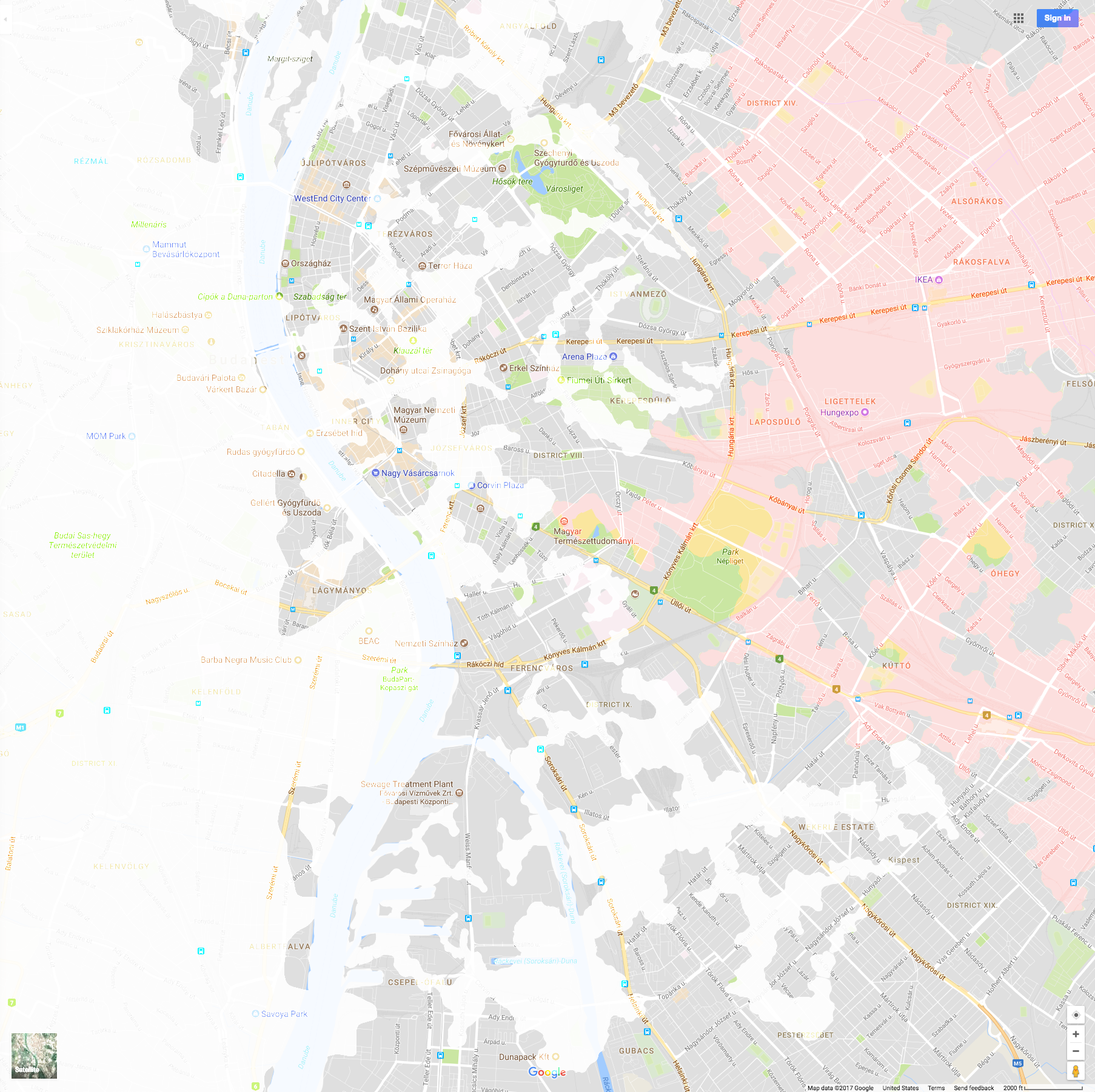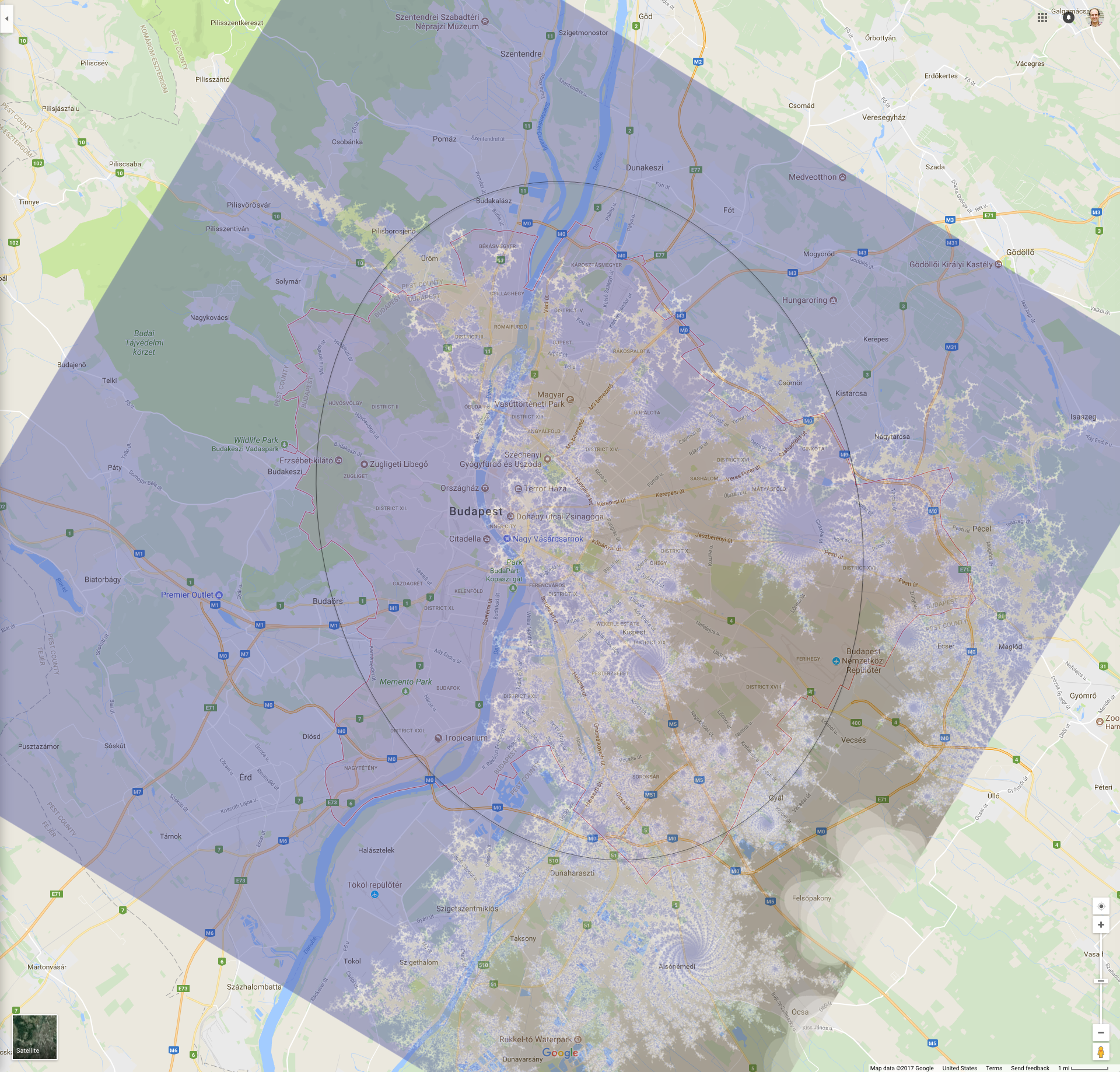My science-fiction work-in-progress is set in a single city, and I needed to see it to imagine living in it. Welcome to Pest! Only walk on gray parts….

Budapest was a proxy in the One-Day War between Greater Russia and Umoja East Africa. Buda is now the White Lake, a boiling toxic waste of microscopic robots that eat carbon dioxide, and anything else, to make diamonds that wash on its shores. Both embargoed no-person’s-land and boomtown, Pest houses thieves, smugglers, engineers, and skaters, daredevil gladiators who jump and spin over the Lake in maglev boots, just one fall from death.
I suppose I could have done any old thing to ruin a city, but I wanted a dusting of Science! in my fiction. I thought a fractal would make a believably consistent result small enough for microscopic robots to store. I used FractalWorks, a Mac app, to generate a tiny portion of the celebrated Mandelbrot function, and overlaid this on a large screenshot of central Budapest, so its finer arcs and whorls were the length of city blocks.

I didn’t think at the scale of blocks it could ever be so precise – if nothing else, land would collapse – so I cut out the Lake using an image editor’s predictive selection tool, to make the edges sloppy and eroded.
Both the pink and white areas are products of the fractal. The white is the Lake itself, while the pink represents Soft Lands, areas of shifting underground streams through which nanites recharge, around which smugglers tunnel.
It’s been a huge help to have the reference. Putting my characters on a literal map lets me figure out relative distances, and helps me imagine the land and the city that might grow from it.
I also thought further about my mechanical monster’s makeup. Where Lake meets land has always been seductively quiet, since earliest drafts. Instead, let the meeting of Lake and Soft Lands be a place of churn and upheaval, the turbulence of nanites going into and out of dormancy around the buzz of other nanites quantumly-uncertain just where their strange fractal stops. I have a heart murmur too.
It’s easier to name things in the context of the city’s weird sense of humor now, and I’m looking at it as more impressively built than previous drafts. Where before it was falling apart and hastily erected, now I see it as printed and reprinted, strange but regular, by the same artificially-intelligent drone “taxibots” that run the city services. This has new virtues and a very different look. And some rewriting.
If this map gets reproduced in the book, I don’t want the plain line drawing quality of most novel maps. Rather I’d commission a graphic artist to generate a cityscape, degrade that so it looked like a 12th-generation-photocopy of an old image, have all the landmarks written in sloppy marker. At top: “Welcome to Pest where you will likely die.” At bottom: “Wanna know more? Live and learn.”
Tag: sci-fi
-
Destroying Budapest
Budapest map and Mandelbrot sliver -
Robots vs. androids in fiction (go robots!)
Among the characters in my new novel is a collective of former package-delivery drones that, after a war, evolved themselves into a taxi service for their damaged city.
From the earliest drafts, I saw them as small flying saucers, with only a central trunk/harness to carry goods or a seated cross-legged person. It took a little time before I saw the plot and character possibilities of robots without hands or appendages. It meant that they had continued to evolve themselves to depend on people, both as customers and even as mechanics, like Thomas the Tank Engine.
I also gave them a limited vocabulary of green and red lights, suitable for bargaining over fares, but akin to the radiation-wounded Christopher Pike on old Star Trek. This made for a stranger, more labored interaction, but one familiar to anyone who has set a digital device.
It also made it easier for the taxibots credibly to be taken for granted by the people around them while they — well, you’ll read it one day. 🙂
This is a less common take on manufactured beings. (more…) -
NaNoWriMo recap (winner!)
National Novel Writing Month was a huge personal success for me, and a big confidence booster. I will miss my silicone NaNoWriMo bracelet tomorrow.
By the numbers, 50,028 words, finished in the wee hours of November 27. On the twenty-three days I wrote, I averaged 2,175 words a day, due mainly to a big push in the first two weeks that had me writing close to 2,500 a day.
As a project, I reached the end of the draft narrative. I kept control of the pacing so I landed it roughly as I intended. It was an active effort, matching my word count to the outlines, planning scenes ahead in 500-word increments, fleshing out passages still short of their part of the total.
However measured, when I could write, I did, at speed and with some level of consistent craft throughout. I’m not sure I believed I could do it. I am glad to no longer have to rely on belief.
I don’t think I have universal advice, but for me it started well before November 1. (more…) -
My return to writing, via NaNoWriMo
I have long been absent from public life and social media. In July I had severe medical problems – short-lived, thankfully, but requiring rest.
In some way, the medical problems deflated me. My mood, always a little low to begin with, got lower still. I could manage family obligations, and family joys, but I was discouraged, and lost my way in my booklife.
I am still finishing the serial. But, in my lows, I saw that both my novel and the serial are very rigid stories, requiring a lot of facts or details from the real world. I wanted to give my imagination a free rein.
Thus I am doubling down on my existing commitments to the serial by doing NaNoWriMo, an attempt to put down fifty thousand original words of a new novel (as much as The Great Gatsby plus a long Sunday magazine article) between November 1 and 30. (more…) -
The pre-apocalypse
My writing group noted that my new story, though a different setting, is also a post-apolcyalypse tale, or at least post-disaster. One colleague included my novel in that theme, even though in my novel things are good, but about to get worse. It’s pre-apocalyptic, she said.
Something in that. My faith is that humanity will persist, but a lot of bad things are going to happen. By the standards of the past they already have. Like my mentor Philip K Dick, I’m less pinpointing details of the great shift, just exploring scenes after upheaval, where people have adapted to far different norms of environment and behavior. I no doubt absorbed this from my family history, for my parents fled war and Soviet occupation, and my own late 20th century life, where we took on huge social changes, and where the rest of the world changed vastly more. I greatly admire writers like Jim Shepard and Harlan Ellison, who change up place and time each story yet keep consistent in their approach and style.
Perhaps I’ll be more sensitive to this strain of pre-apocalyptic. I hope it will give me a way to glide across genre. I would enjoy writing historical. (more…) -
The Autumn 2013 Plan
Speaking strictly commercially, I did everything wrong with my writing. I don’t have an identifiable genre or sub-genre. It’s a literary noir-styled fantasy thriller romance and an allegory about globalization and growing up. There’s no shelf for that. Crossing genres and styles is gaining popularity, but it’s still a hard sell to make cold.
Perhaps I could have written odd short stories and gained a following, but my novel had too strong a pull. And of course I had to write it five times over. And it’s still a big book.
So. There it is. Nothing to do about it now but change course. (more…) -
Science fiction as time travel
I grew up on a solid diet of science fiction, and as a young man in the 1970s and 1980s I had a wide range of style to choose from — New Wave, Old Guard, the Cyberpunks. To read them all at once was like the old Evolution of Man posters, the history of the future all in view.
Like the time-traveler who uses knowledge of the future to succeed, I became a technology early-adopter by reading science-fiction. When I saw it happening for real in the 1980s, as limited and clunky as it was, I already knew what it was going to be. Twenty years ago I even lucked into a job in the field, first learning then explaining to others just what “online” was. That job is done.
I am running out of futures.
(more…)